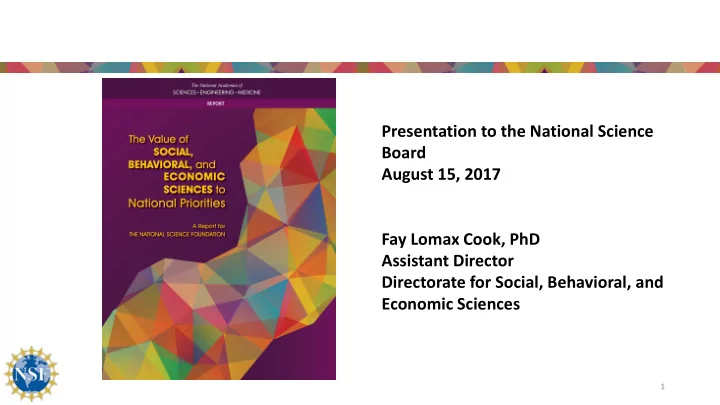

Presentation to the National Science Board August 15, 2017 Fay Lomax Cook, PhD Assistant Director Directorate for Social, Behavioral, and Economic Sciences 1
Cha harge e to t the he C Committee ee 1. Do the SBE sciences advance the NSF mission areas of national health, prosperity, and welfare ; securing the national defense ; and promoting the progress of science ? 2. Do the SBE sciences advance the missions of other federal agencies? 3. Do the SBE sciences advance the work of business and industry ? 4. What are priorities for NSF investment in the SBE sciences, and what are important considerations for the NSF for future strategic planning? 2
Commit ittee on on the e Val alue of of Socia ial, l, B Beh ehavio ioral, , an and d Economic ic S Scie iences t to o Natio ional l Prio ioritie ies s ALAN I. LESHNER (Chair), American Association for the Advancement of Science JOHN S. CARROLL , Sloan School of Management, Massachusetts Institute of Technology IVY ESTABROOKE , Utah Science, Technology and Research Agency, Salt Lake City, Utah RALPH GARRUTO , Department of Anthropology, State University of New York, Binghamton KATHLEEN MULLAN HARRIS , Carolina Population Center, University of North Carolina at Chapel Hill RON HASKINS , Center on Children and Families, The Brookings Institution, Washington, DC EDWARD H. KAPLAN , Yale School of Management, Yale University RONALD D. LEE , Department of Economics, University of California, Berkeley ROBERT MOFFITT , Department of Economics, Johns Hopkins University DUNCAN WATTS , Microsoft Corporation, New York, New York YANNIS C. YORTSOS , Viterbi School of Engineering, University of Southern California 3
Res esponse t to o the q e ques estio ion: : Why S y Support t Socia ial, l, Behavioral l and d Economic ( (SBE) E) R Research? ? • Virtually every major challenge the United States faces requires understanding the causes and consequences of people’s behavior. • Even those that at first glance appear to be issues only of medicine or engineering or computer science have SBE components. • Like all sciences, the social sciences bring a rigorous, methodical approach to pursuing knowledge. 4
The C e Commit ittee R Rea each ched T Three C Con onclu clusio ions. . Concl clusion on 1 1 Overall, the social, behavioral, and economic sciences produce a better understanding of the human aspects of the natural world, contributing knowledge, methods, and tools that further the mission of NSF . • Health • Prosperity and welfare • National defense • Progress of science 5
Conclusion on 2 2 The understanding, tools, and methods provided by the social, behavioral, and economic provide an essential foundation that helps other agencies achieve their missions . • Auctioning off radio frequencies (FCC) • Containing Ebola (CDC) • Improving national security, intelligence and counterterrorism (DoD and other agencies) 6
Conclusion on 3 3 The social, behavioral, and economic sciences have provided advances in understanding and tools and methods that have been applicable to business and industry and that enhanced the U.S. economy . • Development of internet search engines • Using the altitudes of the world population to inform product development and marketing Cohen and Small (1998) PNAS vol. 95 7
Preparin ing f for th the F Futu ture: : Prio iorit itie ies a and E Elements s NSF S Should C Consid ider i in i its ts Str trategic P ic Plannin ing g 1. Undertake a systematic and transparent strategic planning process 2. Attend to current trends in science 3. Support training consistent with ways science is evolving across all scientific fields (e.g., interdisciplinary, data intensive, and team-oriented) 4. Strengthen communication of SBE research 8
Report-Rel elated ed A Actions t s to Da o Date ( e (since J e June, une, 2 201 017) ) 1. Multiple briefings by the NASEM Committee Chair or members (for NSF, Congressional Committees, SBE disciplinary associations) 2. Report highlighted in House of Representatives by Representative Daniel Lipinski Alan Leshner 3. Public discussion of the report at the National Academies, 7/19/17 a) Increased awareness and raised salience of the report to a wide audience (researchers, other federal agencies, Congressional staff) b) Reinforced and expanded findings of the report Marcia McNutt c) Will inform next steps for NSF/SBE strategic planning 9
Next S Step eps t to A Add ddress ess N NAS R Recommen endations s for S Strategic P Planning g 1. Examine other agencies’ strategic planning process 2. Define the goals of SBE’s strategic plan 3. Identify the plan’s audience(s) 4. Solicit input from NSF leadership and staff, the SBE and other research communities, the SBE Advisory Committee, the National Academies, and other relevant stakeholders including industry, foundations, etc. 5. . . . and today, the National Science Board! Thank you! 10
Recommend
More recommend